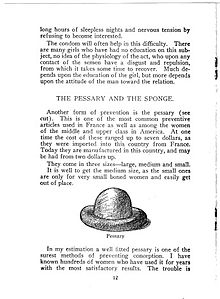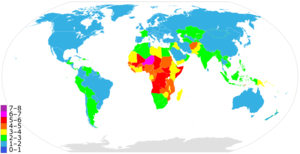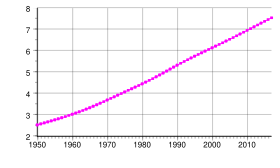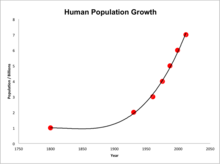Margaret Sanger
| |
|---|---|

Sanger in 1922
| |
| Born |
Margaret Louise Higgins
September 14, 1879
Corning, New York, U.S.
|
| Died | September 6, 1966 (aged 86)
Tucson, Arizona, U.S.
|
| Occupation | Social reformer, sex educator, writer, nurse |
| Spouse(s) |
William Sanger
(m. 1902; div. 1921)
James Noah H. Slee
(m. 1922; d. 1943) |
| Children | 3 |
Margaret Higgins Sanger (born Margaret Louise Higgins, September 14, 1879 – September 6, 1966, also known as Margaret Sanger Slee) was an American birth control activist, sex educator, writer, and nurse. Sanger popularized the term "birth control", opened the first birth control clinic in the United States, and established organizations that evolved into the Planned Parenthood Federation of America.
Sanger used her writings and speeches primarily to promote her way of thinking. She was prosecuted for her book Family Limitation under the Comstock Act in 1914. She was afraid of what would happen, so she fled to Britain until she knew it was safe to return to the US. Sanger's efforts contributed to several judicial cases that helped legalize contraception in the United States. Due to her connection with Planned Parenthood, Sanger is a frequent target of criticism by opponents of abortion. However, Sanger drew a sharp distinction between birth control and abortion and was opposed to abortion through the bulk of her career. Sanger remains an admired figure in the American reproductive rights movement. She has been criticized for supporting eugenics.
In 1916, Sanger opened the first birth control clinic in the United States, which led to her arrest for distributing information on contraception, after an undercover policewoman bought a copy of her pamphlet on family planning. Her subsequent trial and appeal generated controversy. Sanger felt that in order for women to have a more equal footing in society and to lead healthier lives, they needed to be able to determine when to bear children. She also wanted to prevent so-called back-alley abortions, which were common at the time because abortions were illegal in the United States. She believed that while abortion was sometimes justified it should generally be avoided, and she considered contraception the only practical way to avoid them.
In 1921, Sanger founded the American Birth Control League, which later became the Planned Parenthood Federation of America. In New York City, she organized the first birth control clinic staffed by all-female doctors, as well as a clinic in Harlem with an all African-American advisory council, where African-American staff were later added. In 1929, she formed the National Committee on Federal Legislation for Birth Control, which served as the focal point of her lobbying efforts to legalize contraception in the United States. From 1952 to 1959, Sanger served as president of the International Planned Parenthood Federation. She died in 1966, and is widely regarded as a founder of the modern birth control movement.
Life
Early life
With sons Grant and Stuart, c. 1919
Sanger was born Margaret Louise Higgins in 1879 in Corning, New York,
to Irish Catholic parents—a "free-thinking" stonemason father, Michael
Hennessey Higgins, and Anne Purcell Higgins. Michael had immigrated to
the United States aged 14, joining the Army in the Civil War as a
drummer aged 15. Upon leaving the army, he studied medicine and phrenology but ultimately became a stonecutter, chiseling-out angels, saints, and tombstones. Michael became an atheist and an activist for women's suffrage and free public education.
Anne accompanied her family to Canada during the Potato Famine. She married Michael in 1869.
In 22 years, Anne Higgins conceived 18 times, birthing 11 alive before
dying aged 49. Sanger was the sixth of 11 surviving children, spending her tender years submitted to the sharing of household chores and care of family members.
Supported by her two older sisters, Margaret Higgins attended Claverack College and Hudson River Institute, before enrolling in 1900 at White Plains Hospital as a nurse probationer. In 1902, she married architect William Sanger, giving up her education. Suffering from consumption (recurring active tubercular), Margaret Sanger was able to bear three children, and the five settled down to a quiet life in Westchester, New York.
Social activism
In 1911, after a fire destroyed their home in Hastings-on-Hudson,
the Sangers abandoned the suburbs for a new life in New York City.
Margaret Sanger worked as a visiting nurse in the slums of the East Side,
while her husband worked as an architect and a house painter. Already
imbued with her husband's leftist politics, Margaret Sanger also threw
herself into the radical politics and modernist values of pre-World War I
Greenwich Village bohemia. She joined the Women's Committee of the New York Socialist party, took part in the labor actions of the Industrial Workers of the World (including the notable 1912 Lawrence textile strike and the 1913 Paterson silk strike) and became involved with local intellectuals, left-wing artists, socialists and social activists, including John Reed, Upton Sinclair, Mabel Dodge and Emma Goldman.
Sanger's political interests, emerging feminism and nursing
experience led her to write two series of columns on sex education
entitled "What Every Mother Should Know" (1911–12) and "What Every Girl
Should Know" (1912–13) for the socialist magazine New York Call. By the standards of the day, Sanger's articles were extremely frank in their discussion of sexuality, and many New York Call
readers were outraged by them. Other readers, however, praised the
series for its candor. One stated that the series contained "a purer
morality than whole libraries full of hypocritical cant about modesty". Both were published in book form in 1916.
During her work among working-class immigrant women, Sanger met
women who underwent frequent childbirth, miscarriages and self-induced
abortions for lack of information on how to avoid unwanted pregnancy.
Access to contraceptive information was prohibited on grounds of
obscenity by the 1873 federal Comstock law
and a host of state laws. Seeking to help these women, Sanger visited
public libraries, but was unable to find information on contraception.
These problems were epitomized in a story that Sanger would later
recount in her speeches: while Sanger was working as a nurse, she was
called to the apartment of a woman, "Sadie Sachs", who had become
extremely ill due to a self-induced abortion. Afterward, Sadie begged
the attending doctor to tell her how she could prevent this from
happening again, to which the doctor simply advised her to remain
abstinent. His exact words and actions, apparently, were to laugh and
say "You want your cake while you eat it too, do you? Well it can’t be
done. I'll tell you the only sure thing to do .... Tell Jake to sleep on
the roof."
A few months later, Sanger was called back to Sadie's apartment—only
this time, Sadie died shortly after Sanger arrived. She had attempted
yet another self-induced abortion.
Sanger would sometimes end the story by saying, "I threw my nursing bag
in the corner and announced ... that I would never take another case
until I had made it possible for working women in America to have the
knowledge to control birth"; biographer Ellen Chesler attempted
unsuccessfully to find corroboration of this story. There is the strong
possibility Sanger might have deliberately fabricated the whole story as
a propaganda technique.
This story—along with Sanger's 1904 rescue of her unwanted niece Olive Byrne
from the snowbank in which she had been left—marks the beginning of
Sanger's commitment to spare women from the pursuit of dangerous and
illegal abortions.
Sanger opposed abortion, but primarily as a societal ill and public
health danger which would disappear if women were able to prevent
unwanted pregnancy.
Given the connection between contraception and working-class
empowerment, Sanger came to believe that only by liberating women from
the risk of unwanted pregnancy would fundamental social change take
place. She launched a campaign to challenge governmental censorship of
contraceptive information through confrontational actions.
Sanger became estranged from her husband in 1913, and the couple's divorce was finalized in 1921. In 1922, she married her second husband, James Noah H. Slee.
In 1914, Sanger launched The Woman Rebel, an eight-page monthly newsletter which promoted contraception using the slogan "No Gods, No Masters".
Sanger, collaborating with anarchist friends, popularized the term
"birth control" as a more candid alternative to euphemisms such as
"family limitation"; the term "birth control" was suggested in 1914 by a
young friend called Otto Bobstei Sanger proclaimed that each woman should be "the absolute mistress of her own body." In these early years of Sanger's activism, she viewed birth control as a free-speech issue, and when she started publishing The Woman Rebel, one of her goals was to provoke a legal challenge to the federal anti-obscenity laws which banned dissemination of information about contraception. Though postal authorities suppressed five of its seven issues, Sanger continued publication, all the while preparing Family Limitation,
another challenge to anti-birth control laws. This 16-page pamphlet
contained detailed and precise information and graphic descriptions of
various contraceptive methods. In August 1914, Margaret Sanger was
indicted for violating postal obscenity laws by sending The Woman Rebel through the postal system. Rather than stand trial, she fled the country.
Margaret Sanger spent much of her 1914 exile in England, where contact with British neo-Malthusians such as Charles Vickery Drysdale helped refine her socioeconomic justifications for birth control. She shared their concern that over-population led to poverty, famine and war. At the Fifth International Neo-Malthusian Conference in 1922, she was the first woman to chair a session. She organized the Sixth International Neo-Malthusian and Birth-Control Conference that took place in New York in 1925. Over-population would remain a concern of hers for the rest of her life.
During her 1914 trip to England, she was also profoundly influenced by the liberation theories of Havelock Ellis,
under whose tutelage she sought not just to make sexual intercourse
safer for women but more pleasurable. Another notable person she met
around this time was Marie Stopes, who had run into Sanger after she had just given a talk on birth control at a Fabian Society meeting. Stopes showed Sanger her writings and sought her advice about a chapter on contraception.
Early in 1915, Margaret Sanger's estranged husband, William Sanger, gave a copy of Family Limitation to a representative of anti-vice politician Anthony Comstock.
William Sanger was tried and convicted, spending thirty days in jail
while attracting interest in birth control as an issue of civil liberty.
Margaret's second husband, Noah Slee, also lent his help to her life's
work. In 1928, Slee would smuggle diaphragms into New York through
Canada in boxes labeled as 3-In-One Oil. He later became the first legal manufacturer of diaphragms in the United States.
Birth control movement
This page from Sanger's Family Limitation, 1917 edition, describes a cervical cap
Some countries in northwestern Europe had more liberal policies
towards contraception than the United States at the time, and when
Sanger visited a Dutch birth control clinic in 1915, she learned about diaphragms and became convinced that they were a more effective means of contraception than the suppositories and douches
that she had been distributing back in the United States. Diaphragms
were generally unavailable in the United States, so Sanger and others
began importing them from Europe, in defiance of United States law.
On October 16, 1916, Sanger opened a family planning and birth control clinic at 46 Amboy Street in the Brownsville neighborhood of Brooklyn, the first of its kind in the United States.
Nine days after the clinic opened, Sanger was arrested. Sanger's bail
was set at $500 and she went back home. Sanger continued seeing some
women in the clinic until the police came a second time. This time,
Sanger and her sister, Ethel Byrne,
were arrested for breaking a New York state law that prohibited
distribution of contraceptives. Sanger was also charged with running a
public nuisance. Sanger and Byrne went to trial in January 1917.
Byrne was convicted and sentenced to 30 days in a workhouse but went on
a hunger strike. She was force-fed, the first woman hunger striker in
the US to be so treated. Only when Sanger pledged that Byrne would never break the law was she pardoned after ten days.
Sanger was convicted; the trial judge held that women did not have "the
right to copulate with a feeling of security that there will be no
resulting conception."
Sanger was offered a more lenient sentence if she promised to not break
the law again, but she replied: "I cannot respect the law as it exists
today." For this, she was sentenced to 30 days in a workhouse.
An initial appeal was rejected, but in a subsequent court proceeding in
1918, the birth control movement won a victory when Judge Frederick E. Crane of the New York Court of Appeals issued a ruling which allowed doctors to prescribe contraception.
The publicity surrounding Sanger's arrest, trial, and appeal sparked
birth control activism across the United States and earned the support
of numerous donors, who would provide her with funding and support for
future endeavors.
In February 1917, Sanger began publishing the monthly periodical Birth Control Review.
American Birth Control League
Sanger published the Birth Control Review from 1917 to 1929.
After World War I, Sanger shifted away from radical politics, and she founded the American Birth Control League (ABCL) in 1921 to enlarge her base of supporters to include the middle class. The founding principles of the ABCL were as follows:
We hold that children should be (1) Conceived in love; (2) Born of the mother's conscious desire; (3) And only begotten under conditions which render possible the heritage of health. Therefore we hold that every woman must possess the power and freedom to prevent conception except when these conditions can be satisfied.
After Sanger's appeal of her conviction for the Brownsville clinic
secured a 1918 court ruling that exempted physicians from the law
prohibiting the distribution of contraceptive information to women
(provided it was prescribed for medical reason), she established the
Clinical Research Bureau (CRB) in 1923 to exploit this loophole. The CRB was the first legal birth control clinic in the United States, staffed entirely by female doctors and social workers. The clinic received extensive funding from John D. Rockefeller Jr. and his family, who continued to make anonymous donations to Sanger's causes in subsequent decades.
John D. Rockefeller Jr. donated five thousand dollars to her American Birth Control League in 1924 and a second time in 1925.
In 1922, she traveled to China, Korea, and Japan. In China, she observed
that the primary method of family planning was female infanticide, and
she later worked with Pearl Buck to establish a family planning clinic in Shanghai. Sanger visited Japan six times, working with Japanese feminist Kato Shidzue to promote birth control. This was ironic, since ten years earlier Sanger had accused Katō of murder and praised an attempt to kill her.
In 1928, conflict within the birth control movement leadership
led Sanger to resign as the president of the ABCL and take full control
of the CRB, renaming it the Birth Control Clinical Research Bureau
(BCCRB), marking the beginning of a schism that would last until 1938.
Sanger invested a great deal of effort communicating with the
general public. From 1916 onward, she frequently lectured (in churches,
women's clubs, homes, and theaters) to workers, churchmen, liberals,
socialists, scientists, and upper-class women. She once lectured on birth control to the women's auxiliary of the Ku Klux Klan in Silver Lake, New Jersey.
In her autobiography, she described the experience as "weird", and
reported having the impression that the audience were all half-wits, and
speaking in the simplest possible language, as if she were talking to
children.
She wrote several books in the 1920s which had a nationwide
impact in promoting the cause of birth control. Between 1920 and 1926,
567,000 copies of Woman and the New Race and The Pivot of Civilization were sold. She also wrote two autobiographies designed to promote the cause. The first, My Fight for Birth Control, was published in 1931 and the second, more promotional version, Margaret Sanger: An Autobiography, was published in 1938.
During the 1920s, Sanger received hundreds of thousands of
letters, many of them written in desperation by women begging for
information on how to prevent unwanted pregnancies. Five hundred of these letters were compiled into the 1928 book, Motherhood in Bondage.
Work with the African-American community
W. E. B. Du Bois served on the board of Sanger's Harlem clinic
Sanger worked with African American leaders and professionals who saw a need for birth control in their communities. In 1929, James H. Hubert, a black social worker and the leader of New York's Urban League, asked Sanger to open a clinic in Harlem. Sanger secured funding from the Julius Rosenwald Fund
and opened the clinic, staffed with black doctors, in 1930. The clinic
was directed by a 15-member advisory board consisting of black doctors,
nurses, clergy, journalists, and social workers. The clinic was
publicized in the African-American press as well as in black churches,
and it received the approval of W. E. B. Du Bois, the co-founder of the NAACP and the editor of its magazine, The Crisis. Sanger did not tolerate bigotry among her staff, nor would she tolerate any refusal to work within interracial projects. Sanger's work with minorities earned praise from Martin Luther King, Jr., in his 1966 acceptance speech for the Margaret Sanger award.
From 1939 to 1942, Sanger was an honorary delegate of the Birth
Control Federation of America, which included a supervisory
role—alongside Mary Lasker and Clarence Gamble—in the Negro Project, an effort to deliver information about birth control to poor black people.
Sanger advised Dr. Gamble on the utility of hiring a black physician
for the Negro Project. She also advised him on the importance of
reaching out to black ministers, writing:
The ministers work is also important and also he should be trained, perhaps by the [Birth Control] Federation [of America] as to our ideals and the goal that we hope to reach. We do not want word to go out that we want to exterminate the Negro population and the minister is the man who can straighten out that idea if it ever occurs to any of their more rebellious members.
New York University's Margaret Sanger Papers Project says that
though the letter would have been meant to avoid the mistaken notion
that the Negro Project was a racist campaign, detractors of Sanger, such
as Angela Davis, have interpreted the passage "as evidence she led a calculated effort to reduce the black population against their will".
Planned Parenthood era
Sanger's Birth Control Clinical Research Bureau operated from this New York building from 1930 to 1973
In 1929, Sanger formed the National Committee on Federal Legislation
for Birth Control in order to lobby for legislation to overturn
restrictions on contraception. That effort failed to achieve success, so Sanger ordered a diaphragm
from Japan in 1932, in order to provoke a decisive battle in the
courts. The diaphragm was confiscated by the United States government,
and Sanger's subsequent legal challenge led to a 1936 court decision which overturned an important provision of the Comstock laws which prohibited physicians from obtaining contraceptives. This court victory motivated the American Medical Association in 1937 to adopt contraception as a normal medical service and a key component of medical school curriculums.
This 1936 contraception court victory was the culmination of
Sanger's birth control efforts, and she took the opportunity, now in her
late 50s, to move to Tucson, Arizona, intending to play a less critical
role in the birth control movement. In spite of her original
intentions, she remained active in the movement through the 1950s.
In 1937, Sanger became chairman of the newly formed Birth Control
Council of America, and attempted to resolve the schism between the
ABCL and the BCCRB. Her efforts were successful, and the two organizations merged in 1939 as the Birth Control Federation of America.
Although Sanger continued in the role of president, she no longer
wielded the same power as she had in the early years of the movement,
and in 1942, more conservative forces within the organization changed
the name to Planned Parenthood Federation of America, a name Sanger
objected to because she considered it too euphemistic.
In 1948, Sanger helped found the International Committee on Planned Parenthood, which evolved into the International Planned Parenthood Federation
in 1952, and soon became the world's largest non-governmental
international women's health, family planning and birth control
organization. Sanger was the organization's first president and served
in that role until she was 80 years old. In the early 1950s, Sanger encouraged philanthropist Katharine McCormick to provide funding for biologist Gregory Pincus to develop the birth control pill which was eventually sold under the name Enovid.
Pincus had recruited Dr. John Rock, Harvard gynecologist, to
investigate clinical use of progesterone to prevent ovulation.
(Jonathan Eig (2014). "The Birth of the Pill: How Four Crusaders
Reinvented Sex and Launched a Revolution." W. W. Norton & Company.
New York. London. pp. 104ff.) Pincus would often say that he never
could have done it without Sanger, McCormick, and Rock. (Ibid.,
p. 312.)
Death
Sanger died of congestive heart failure in 1966 in Tucson, Arizona, aged 86, about a year after the U.S. Supreme Court case Griswold v. Connecticut, which legalized birth control in the United States. Sanger is buried in Fishkill, New York, next to her sister, Nan Higgins, and her second husband, Noah Slee. One of her surviving brothers was College Football Hall of Fame player and Pennsylvania State University Head Football coach Bob Higgins.
Views
Sexuality
While researching information on contraception, Sanger read treatises on sexuality including The Psychology of Sex by the English psychologist Havelock Ellis and was heavily influenced by it. While traveling in Europe in 1914, Sanger met Ellis. Influenced by Ellis, Sanger adopted his view of sexuality as a powerful, liberating force.
This view provided another argument in favor of birth control, as it
would enable women to fully enjoy sexual relations without fear of
unwanted pregnancy. Sanger also believed that sexuality, along with birth control, should be discussed with more candor, and praised Ellis for his efforts in this direction. She also blamed Christianity for the suppression of such discussion.
Sanger opposed excessive sexual indulgence. She wrote that
"every normal man and woman has the power to control and direct his
sexual impulse. Men and women who have it in control and constantly use
their brain cells thinking deeply, are never sensual."
Sanger said that birth control would elevate women away from a position
of being an object of lust and elevate sex away from purely being for
satisfying lust, saying that birth control "denies that sex should be
reduced to the position of sensual lust, or that woman should permit
herself to be the instrument of its satisfaction."
Sanger wrote that masturbation was dangerous. She stated: "In my
personal experience as a trained nurse while attending persons afflicted
with various and often revolting diseases, no matter what their
ailments, I never found any one so repulsive as the chronic masturbator.
It would not be difficult to fill page upon page of heart-rending
confessions made by young girls, whose lives were blighted by this
pernicious habit, always begun so innocently."
She believed that women had the ability to control their sexual
impulses, and should utilize that control to avoid sex outside of
relationships marked by "confidence and respect". She believed that
exercising such control would lead to the "strongest and most sacred
passion".
However, Sanger was not opposed to homosexuality and praised Ellis for
clarifying "the question of homosexuals ... making the thing a—not
exactly a perverted thing, but a thing that a person is born with
different kinds of eyes, different kinds of structures and so forth
... that he didn't make all homosexuals perverts—and I thought he helped
clarify that to the medical profession and to the scientists of the
world as perhaps one of the first ones to do that."
Freedom of speech
Sanger opposed censorship throughout her career. Sanger grew up in a home where orator Robert Ingersoll was admired.
During the early years of her activism, Sanger viewed birth control
primarily as a free-speech issue, rather than as a feminist issue, and
when she started publishing The Woman Rebel in 1914, she did so
with the express goal of provoking a legal challenge to the Comstock
laws banning dissemination of information about contraception. In New York, Emma Goldman introduced Sanger to members of the Free Speech League, such as Edward Bliss Foote and Theodore Schroeder, and subsequently the League provided funding and advice to help Sanger with legal battles.
Over the course of her career, Sanger was arrested at least eight
times for expressing her views during an era in which speaking publicly
about contraception was illegal.
Numerous times in her career, local government officials prevented
Sanger from speaking by shuttering a facility or threatening her hosts. In Boston in 1929, city officials under the leadership of James Curley
threatened to arrest her if she spoke. In response she stood on stage,
silent, with a gag over her mouth, while her speech was read by Arthur M. Schlesinger, Sr.
Eugenics
Her 1920 book endorsed negative eugenics
After World War I,
Sanger increasingly appealed to the societal need to limit births by
those least able to afford children. The affluent and educated already
limited their child-bearing, while the poor and uneducated lacked access
to contraception and information about birth control. Here she found an area of overlap with eugenicists.
She believed that they both sought to "assist the race toward the
elimination of the unfit." They differed in that "eugenists imply or
insist that a woman's first duty is to the state; we contend that her
duty to herself is her duty to the state."
Sanger was a proponent of negative eugenics, which aimed to improve
human hereditary traits through social intervention by reducing the
reproduction of those who were considered unfit.
Sanger's view of eugenics was influenced by Havelock Ellis and other British eugenicists, who held that environmentally acquired traits were inherited by one's progeny.
She did not speak specifically to the idea of race or ethnicity being
determining factors and "although Sanger articulated birth control in
terms of racial betterment and, like most old-stock Americans, supported
restricted immigration, she always defined fitness in individual rather
than racial terms."
Instead, she stressed limiting the number of births to live within
one's economic ability to raise and support healthy children. This would
lead to a betterment of society and the human race. Sanger's view put her at odds with leading American eugenicists, such as Charles Davenport, who took a racist view of inherited traits. In A History of the Birth Control Movement in America,
Engelman also noted that "Sanger quite effortlessly looked the other
way when others spouted racist speech. She had no reservations about
relying on flawed and overtly racist work to serve her own propaganda
needs."
In "The Morality of Birth Control", a 1921 speech, she divided
society into three groups: the "educated and informed" class that
regulated the size of their families, the "intelligent and responsible"
who desired to control their families in spite of lacking the means or
the knowledge, and the "irresponsible and reckless people" whose
religious scruples "prevent their exercising control over their
numbers". Sanger concludes, "There is no doubt in the minds of all
thinking people that the procreation of this group should be stopped."
Sanger's eugenic policies included an exclusionary immigration policy, free access to birth control methods, and full family planning autonomy for the able-minded, as well as compulsory segregation or sterilization for the "profoundly retarded".
Sanger wrote, "we [do not] believe that the community could or should
send to the lethal chamber the defective progeny resulting from
irresponsible and unintelligent breeding." In personal correspondence she expressed her sadness about the aggressive and lethal Nazi eugenics program, and donated to the American Council Against Nazi Propaganda.
Sanger believed that self-determining motherhood was the only unshakable foundation for racial betterment.
Initially she advocated that the responsibility for birth control
should remain with able-minded individual parents rather than the state.
Later, however, she proposed that "Permits for parenthood shall be
issued upon application by city, county, or state authorities to married
couples."
Sanger justified her decision to speak to a women's auxiliary of the Ku Klux Klan group by explaining, "to me any aroused group is a good group." She was closely associated with one of the most influential and extreme racist authors in America in the 1920s and 1930s, the Klansman and Nazi sympathizer Lothrop Stoddard. Chesler comments:
Margaret Sanger was never herself a racist, but she lived in a profoundly bigoted society, and her failure to repudiate prejudice—especially when it was manifest among proponents of her cause—has haunted her ever since.
Abortion
Margaret
Sanger opposed abortion and sharply distinguished it from birth
control, the latter being a fundamental right of women, the former being
a shameful crime.
In 1916, when she opened her first birth control clinic, she was
employing harsh rhetoric against abortion. Flyers she distributed to
women exhorted them in all capitals: "Do not kill, do not take life, but
prevent."
Sanger's patients at that time were told "that abortion was the wrong
way—no matter how early it was performed it was taking life; that
contraception was the better way, the safer way—it took a little time, a
little trouble, but it was well worth while in the long run, because
life had not yet begun."
Sanger consistently distanced herself from any calls for legal access
to abortion, arguing that legal access to contraceptives would remove
the need for abortion. Ann Hibner Koblitz
has argued that Sanger's anti-abortion stance contributed to the
further stigmatization of abortion and impeded the growth of the broader
reproductive rights movement.
While Margaret Sanger condemned abortion as a method of family
limitation, she was not opposed to abortion intended to save a woman's
life.
Furthermore, in 1932, Margaret Sanger directed the Clinical Research
Bureau to start referring patients to hospitals for therapeutic
abortions when indicated by an examining physician.
She also advocated for birth control so that the pregnancies that led
to therapeutic abortions could be prevented in the first place.
Legacy
Margaret Sanger Square, at the intersection of Mott Street and Bleecker Street in Manhattan
Sanger's writings are curated by two universities: New York University's history department maintains the Margaret Sanger Papers Project, and Smith College's Sophia Smith Collection maintains the Margaret Sanger Papers collection.
Sanger's story also features in several biographies, including David Kennedy's biography Birth Control in America: The Career of Margaret Sanger (1970), which won the Bancroft Prize and the John Gilmary Shea Prize. She is also the subject of the television films Portrait of a Rebel: The Remarkable Mrs. Sanger (1980), and Choices of the Heart: The Margaret Sanger Story (1995). In 2013, the American cartoonist Peter Bagge published Woman Rebel, a full-length graphic-novel biography of Sanger.
Sanger has been recognized with several honors. Her speech
"Children's Era", given in 1925, is listed as #81 in American Rhetoric's
Top 100 Speeches of the 20th Century (listed by rank). Sanger was an inspiration for Wonder Woman, a comic-book character introduced by William Marston
in 1941. Marston was influenced by early feminist thought while in
college, and later formed a romantic relationship with Sanger's niece, Olive Byrne. According to Jill Lepore,
several Wonder Woman story lines were at least in part inspired by
Sanger, like the character's involvement with different labor strikes
and protests. Between (and including) 1953 and 1963, Sanger was nominated for the Nobel Peace Prize 31 times. In 1957, the American Humanist Association named her Humanist of the Year. In 1966, Planned Parenthood began issuing its Margaret Sanger Awards
annually to honor "individuals of distinction in recognition of
excellence and leadership in furthering reproductive health and
reproductive rights". The 1979 artwork The Dinner Party features a place setting for her. In 1981, Sanger was inducted into the National Women's Hall of Fame. In 1993, the United States National Park Service designated the Margaret Sanger Clinic—where she provided birth-control services in New York in the mid-twentieth century—as a National Historic Landmark.
As well, government authorities and other institutions have
memorialized Sanger by dedicating several landmarks in her name,
including a residential building on the Stony Brook University campus, a room in Wellesley College's library, and Margaret Sanger Square in New York City's Noho area. There is a bust of Sanger in the National Portrait Gallery, which was a gift from Cordelia Scaife May. Sanger, a crater in the northern hemisphere of Venus, takes its name from Margaret Sanger.
Due to her connection with Planned Parenthood, many who oppose abortion frequently condemn Sanger by criticizing her views on birth control and eugenics. In spite of such controversies, Sanger continues to be regarded as a force in the American reproductive rights movement and women's rights movement.
The Planned Parenthood headquarters on Bleecker Street in New York now bears her name.
Works
Books and pamphlets
- What Every Mother Should Know – Originally published in 1911 or 1912, based on a series of articles Sanger published in 1911 in the New York Call, which were, in turn, based on a set of lectures Sanger gave to groups of Socialist party women in 1910–1911. Multiple editions published through the 1920s, by Max N. Maisel and Sincere Publishing, with the title What Every Mother Should Know, or how six little children were taught the truth ... Online (1921 edition, Michigan State University)
- Family Limitation – Originally published 1914 as a 16-page pamphlet; also published in several later editions. Online (1917, 6th edition, Michigan State University); Online (1920 English edition, Bakunin Press, revised by author from 9th American edition);
- What Every Girl Should Know – Originally published 1916 by Max N. Maisel; 91 pages; also published in several later editions. Online (1920 edition); Online (1922 ed., Michigan State University)
- The Case for Birth Control: A Supplementary Brief and Statement of Facts – May 1917, published to provide information to the court in a legal proceeding. Online (Internet Archive)
- Woman and the New Race, 1920, Truth Publishing, foreword by Havelock Ellis. Online (Harvard University); Online (Project Gutenberg); Online (Internet Archive); Audio on Archive.org
- Debate on Birth Control – 1921, text of a debate between Sanger, Theodore Roosevelt, Winter Russell, George Bernard Shaw, Robert L. Wolf, and Emma Sargent Russell. Published as issue 208 of Little Blue Book series by Haldeman-Julius Co. Online (1921, Michigan State University)
- The Pivot of Civilization, 1922, Brentanos. Online (1922, Project Gutenberg); Online (1922, Google Books)
- Motherhood in Bondage, 1928, Brentanos. Online (Google Books).
- My Fight for Birth Control, 1931, New York: Farrar & Rinehart
- An Autobiography. New York, NY: Cooper Square Press. 1938. ISBN 0-8154-1015-8.
- Fight for Birth Control, 1916, New York (The Library of Congress)
- "Birth Control: A Parent's Problem or Women's?" The Birth Control Review, Mar. 1919, 6–7.
Periodicals
- The Woman Rebel – Seven issues published monthly from March 1914 to August 1914. Sanger was publisher and editor. Sample article The Woman Rebel, Vol. 1, No. 4, June 1914, 25, Margaret Sanger Microfilm, C16:0539.
- Birth Control Review – Published monthly from February 1917 to 1940. Sanger was editor until 1929, when she resigned from the ABCL. Not to be confused with Birth Control News, published by the London-based Society for Constructive Birth Control and Racial Progress.
Collections and anthologies
- Sanger, Margaret, The Selected Papers of Margaret Sanger, Volume 1: The Woman Rebel, 1900–1928, Esther Katz, Cathy Moran Hajo, Peter Engelman (eds.), University of Illinois Press, 2003
- Sanger, Margaret, The Selected Papers of Margaret Sanger, Volume 2: Birth Control Comes of Age, 1928–1939, Esther Katz, Cathy Moran Hajo, Peter Engelman (eds.), University of Illinois Press, 2007
- Sanger, Margaret, The Selected Papers of Margaret Sanger, Volume 3: The Politics of Planned Parenthood, 1939–1966, Esther Katz, Cathy Moran Hajo, Peter Engelman (eds.), University of Illinois Press, 2010
- Works by Margaret Sanger at Project Gutenberg
- The Margaret Sanger Papers at Smith College
- The Margaret Sanger Papers Project at New York University
- McElderry, Michael J. (1976). "Margaret Sanger: A Register of Her Papers in the Library of Congress". Manuscript Division, Library of Congress. Archived from the original on March 29, 2009. Retrieved March 30, 2009.
- Correspondence between Sanger and McCormick, from The Pill documentary movie; supplementary material, PBS, American Experience (producers). Online.
Speeches
- Sanger, Margaret, "The Morality of Birth Control" 1921.
- Sanger, Margaret, "The Children's Era" 1925.
- Sanger, Margaret, "Woman and the Future" 1937.















